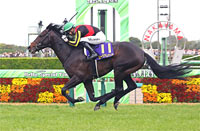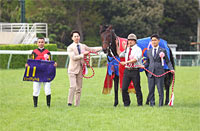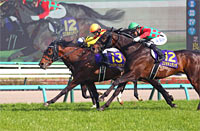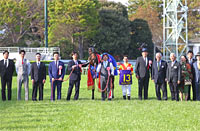2016 News
2016 Satsuki Sho (Japanese 2000 Guineas) (G1) - PreviewThe fillies kicked off the 3-year-old classics last week at Hanshin Racecourse with the Oka Sho (Japanese 1000 Guineas) and this coming Sunday top-level action continues with the 76th running of the Satsuki Sho, or “Azalea Prize,” at Chiba’s Nakayama Racecourse. It’s the first leg of Japan’s Triple Crown, open to both fillies and colts, but the April 17 full gate of 18 will be made up of colts alone this year, all carrying 57kg. They will vie over 2,000 meters of turf at Nakayama for the winner’s prize of 100 million yen from a purse that totals 216 million yen (approximately $1.8 million). This year the spotlight is on a trio of colts – Leontes, Makahiki and Satono Diamond – the latter two unbeaten and both three for three with one graded stakes win to their name each. Unbeaten leading in to the Satsuki Sho, however, is by no means a guarantee of success. With nearly all the runners relatively inexperienced at this point in their careers, it is not uncommon for lesser-proven runners to pocket the crown’s first jewel. Only six horses of the 16 unbeaten runners, who went to the Satsuki Sho gate since it became a graded race in 1984, have finished winners. The last was Deep Impact in 2005. Last year, the field’s two unbeaten contenders, favorite Satono Crown and Kitasan Black finished sixth and third, respectively. Makahiki, whose names derives from the Hawaiian New Year festival, is a son of Deep Impact out of the French Deputy mare Wikiwiki. Makahiki aced his debut at Kyoto under Mirco Demuro but bled from the nose afterward and was given a layoff. He came back for an easy win of the Wakoma Stakes at the same venue, then followed that up with a tougher run in the 2,000-meter Grade 2 Yayoi Sho. It was a close finish that saw the jockey use his whip on the colt for the first time. Makahiki came out on top by a neck over 2015’s 2-year-old champion, Leontes. Paired with Makahiki for his last two starts was Christophe Lemaire, who will instead be aboard Satono Diamond on Sunday. Makahiki will be ridden by Yuga Kawada for the first time. Kawada got in the saddle for the first time for an easy gallop over the woodchip course on March 30 and assistant trainer Yusuke Oe rode fast work the following day. He clocked 85.8 seconds over 6 furlongs, an average overall but a fast last lap of 11.4 seconds. Trainer Yasuo Tomomichi said, “If the jockey rides, the times tend to get too fast, so I had my staff ride. Three horses worked together and I had Makahiki wait in the rear.” Makahiki is full brother to sprinter Uliuli, but the 3-year-old has yet to be unbalanced racing over 1,800 to 2,000 meters. The haul to the track is also not a concern. “He handled the journey to Nakayama for the Yayoi Sho well and his win in that race shows he can go up against top-level horses without a problem,” Oe said. The only factor Makahiki has yet to encounter is a big field. His largest field until now consisted of 12 runners. The other colt who has never tasted defeat is Satono Diamond. Also by Deep Impact and out of the Orpen mare Malpensa, Satono Diamond carried a glitzy price tag of 230 million yen just sixth months from his birth at the Select Sale, but his success in his three career starts would seem to prove his worth thus far. From a Kyoto debut win over 2,000 meters, to a victory at Hanshin over the same distance, Satono Diamond then took on the Grade 3 Kisaragi Sho at Kyoto over 1,800 meters and clinched it by 3 1/2 lengths. Lemaire rode all three races and he took the reins for a fast gallop on March 31 for the first time since the Feb. 7 Kisaragi Sho. “He feels great. I am very happy to have the ride on him. He’s a very easy horse to ride. He has more power now than before,” Lemaire said. Lemaire will surely be gunning to avenge his loss aboard race favorite Major Emblem last week in the Oka Sho. Trainer Yasutoshi Ikee also noted the colt’s improvement since the Satsuki Sho trial two months ago. “He’d looked a bit lacking but now he’s filled out, has gotten broader and is looking more like a colt,” Ikee said. Satono Diamond’s win of the Kisaragi Sho also showed Ikee that the colt, who had raced on only soft and slightly yielding turf before, could handle a fast track as well. “I’d wondered what kind of footwork he’d give us on a fast track and he gave us just what the track called for. So that’s one issue cleared up,” Ikee said. Of Leontes and Makahiki, Ikee said, “Those two are strong and I wonder just how far they’ll go.” His other concern is his colt’s first trip east to Nakayama from their Ritto Training Center base. Surely giving them all a real ride for the money will be Mirco Demuro, just off a win of the Oka Sho aboard Jeweler. Demuro has four previous Satsuki Sho wins to his name, including last year’s ride on Duramente and current race record holder Logotype (also a 2-year-old champion) in 2013. Demuro is paired with Leontes, the third of the “Big 3” this year and 2-year-old champion for 2015 following his win of the Grade 1 Asahi Hai Futurity Stakes. By King Kamehameha out of the Special Week mare Cesario, Leontes won his debut at Kyoto over 2,000 meters before a leap to victory in the Grade 1 1,600-meter Asahi Hai Futurity Stakes. Last out in the Yayoi Sho and back from a layoff, he narrowly missed the win, losing to Makahiki by a neck. Demuro later said, “We may have got to the front a bit too early. The biggest problem was that he was fresh racing for the first time in a while and he was a bit too full of himself.” Assistant trainer Norihiko Kishimoto says that race “has brought a big change in him. He’s more relaxed and his responses are sharper. And, I think he has more stamina.” Leontes raced from fourth position in the Yayoi Sho, an orthodox style that Kishimoto believes suits him. “I’d like to the see the same kind of race for the Satsuki Sho, even if he’s a bit keen going into the first turn. I think a forward position is good.” Kishimoto also noted, “Makahiki was strong, but this colt didn’t do badly himself. After this is the Derby and I’m looking forward to it,” Kishimoto said of the Triple Crown second leg Tokyo Yushun (Japanese Derby), slated for May 29 at Tokyo Racecourse. King Kamehameha colts have also fared better in the Satsuki Sho than the sons or daughters of Deep Impact. In fact, Deep Impact progeny have yet to win the race, while King Kamehameha colts have made the money for three years in a row – Codino in third in 2013, To the World second in 2014 and Duramente in first last year. Air Spinel and Yutaka Take combine forces in the Satsuki Sho and the son of King Kamekameha is expected to be a favorite to topple the super trio. The colt’s first three races were all over the mile. After a debut win, he captured the Daily Hai Nisai Stakes, then ran second in the Asahi Hai Futurity Stakes. Last out, Air Spinel finished third in the Yayoi Sho, following runnerup Leontes over the line by 2 lengths, but with 5 lengths to the fourth-place finisher Taisei Summit. Admire Daio met Leontes in his debut and finished third, but then went on to win his next three starts in a row. He won the open-class Wakaba Stakes (2,000 meters) at Hanshin by only a nose but was 8 lengths ahead of the third-place finisher. This Deep Impact colt may be best with a bit more distance than 2,000 meters, but he is surely a force to be reckoned with, as is the Deep Impact-sired Dee Majesty, who won the Grade 3 Kyodo News Service Hai (1,800 meters) at Tokyo on Feb. 14 and broke his maiden over 2,000 meters at Tokyo. He also has experience at Nakayama, having run second in a maiden over 1,800 meters. Mount Robson, by Deep Impact, and Lord Quest are two more colts expected to attract the favor of wagerers. The gray Mount Robson ran second in his first two starts, then, following a switch to a clockwise track, aced three in a row, including the Grade 2 Spring Stakes (1,800 meters) last out at Nakayama. Lord Quest, by 2007 Arima Kinen champion Matsurida Gogh, finished second in the Hopeful Stakes (G2, 2,000 meters) at Nakayama last December and was third last out in the Spring Stakes. He’s a bit slow out of the gate and not his best over the tighter turns of Nakayama, but a fast pace may work in his favor. The Satsuki Sho is the 11th race on the Sunday race card at Nakayama. Post time is 15:40 local time.
|

|





















